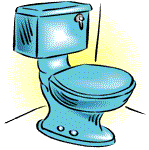 What can you do about a slow flushing toilet? This problem is common in older toilets. Addressing issues with the water quantity and flow will help this issue.
What can you do about a slow flushing toilet? This problem is common in older toilets. Addressing issues with the water quantity and flow will help this issue.
Not sure if this your problem? See the article 'How to Fix a Toilet' for a complete listing of all of the toilet repair topics.
There are (3) Key Topics associated with a 'Slow Flushing Toilet': (1) 'Adjusting the Toilet Tank Water Level' covers a low water supply in the toilet tank. (2) Older toilets and houses with hard water can get a sediment build up in the water inlet. 'Cleaning Out Toilet Sediment' covers this issue. (3) 'Removing Toilet Blockages' talks about partially blocked toilets that will flush slowly.
Toilets are engineered to use a certain amount of water to flush. When the water rushes into the bowl, it creates a siphon that removes the waste and rinses the bowl. Too little water or water that gets there too slow can cause the toilet to flush poorly.
Water Usage for Toilets
Toilets that used a large supply of water would be prone to slow flushes. Hard water and sediment can also be a factor.
A toilet that flushes slowly can be very annoying. When a toilet does not flush properly, clogs are frequent. A clogged toilet is more than irritating. The dirty messy water is no fun and can be a health hazard.
In the mid nineties, toilets had to start using 1.6 gallons of water per flush. Prior to that time toilets could use 3.5 to as high as 7 gallons of water. The design of toilet would require that the full amount be used. In an effort to conserve, some homeowners would adjust the water level down. This will cause the toilet to flush slowly, since there is not enough water pressure to create the proper siphon effect.
Issues With a Slow Flushing Toilet
What Can You Save? - A plumber can usually take care of this problem in a single service call. Normally this will run from $75 to $100. One danger is that the toilet will be condemned and the plumber will try to sell you a new toilet.
How Hard Could It Be? - Fixing the common causes of a slow flushing toilet is not difficult. | These repairs will have a Difficulty Level of: Simple | These repairs require a Skill Level of: Job Jar Specialist | For and explanation of the terms in this section, see 'How to Use This Site'.
Check the Simple Things! - Adjusting the float to set the water level to the correct height is the easiest fix. Most toilets are designed to work properly with the water level at the maximum level in the tank.
What Can Go Wrong? - Not fixing a slow flushing toilet can lead to toilet clogs. A clogged toilet can be very disruptive. Not to mention the mess that can be made by the dirty water. Another issue is that the toilet may need to be flushed multiple times, wasting water.
Troubleshooting a Slow Flushing Toilet
The amount of water in the toilet tank is critical to proper flushing. The article 'Adjusting the Toilet Tank Water Level' provides instructions on adjusting it to the proper level.
Another common problem is a build up of sediment in the inlets for the bowl. If the water does not get into the tank quickly enough, it won't flush properly. See 'Cleaning Out Toilet Sediment' for a review.
'Removing Toilet Obstructions' discusses how a clog or partial clog can affect the operation of your toilet. Removing them is the only choice.
Summary
Were you able to deal with your slow flushing toilet? It may have been as simple as adjusting the float. This is especially true for older toilets. In years gone by, toilets needed a lot of water to flush properly. When the tank level gets too low, the proper siphoning will not start.
Another common problem is sediment in the inlet valve. Again, older toilets are more likely to have this trouble. Then there is the 'object' stuck in the trap. No one knows how is got there, but it sure has caused a problem. Dislodging objects is not too hard and hopefully, you are up and running again.

